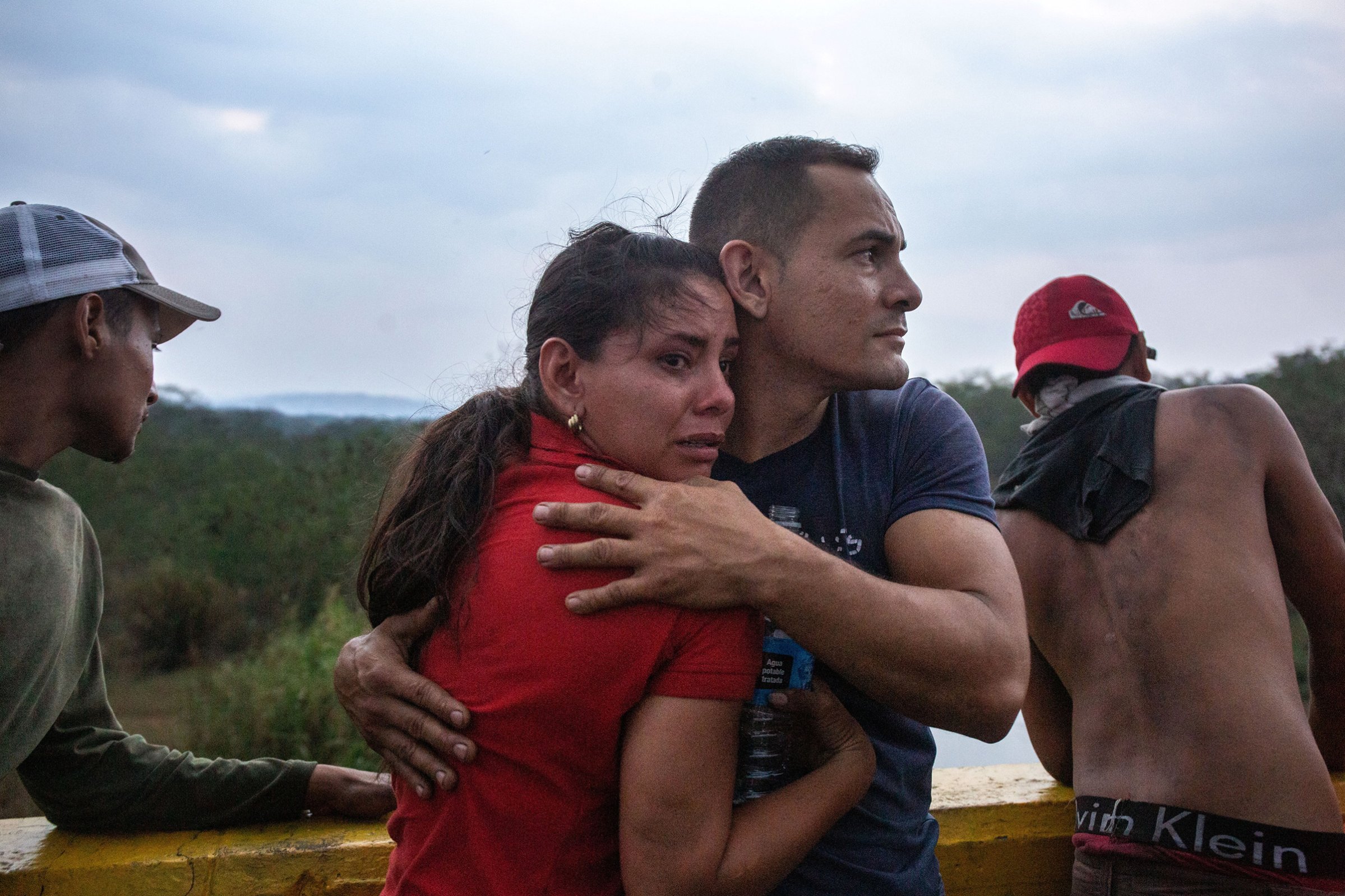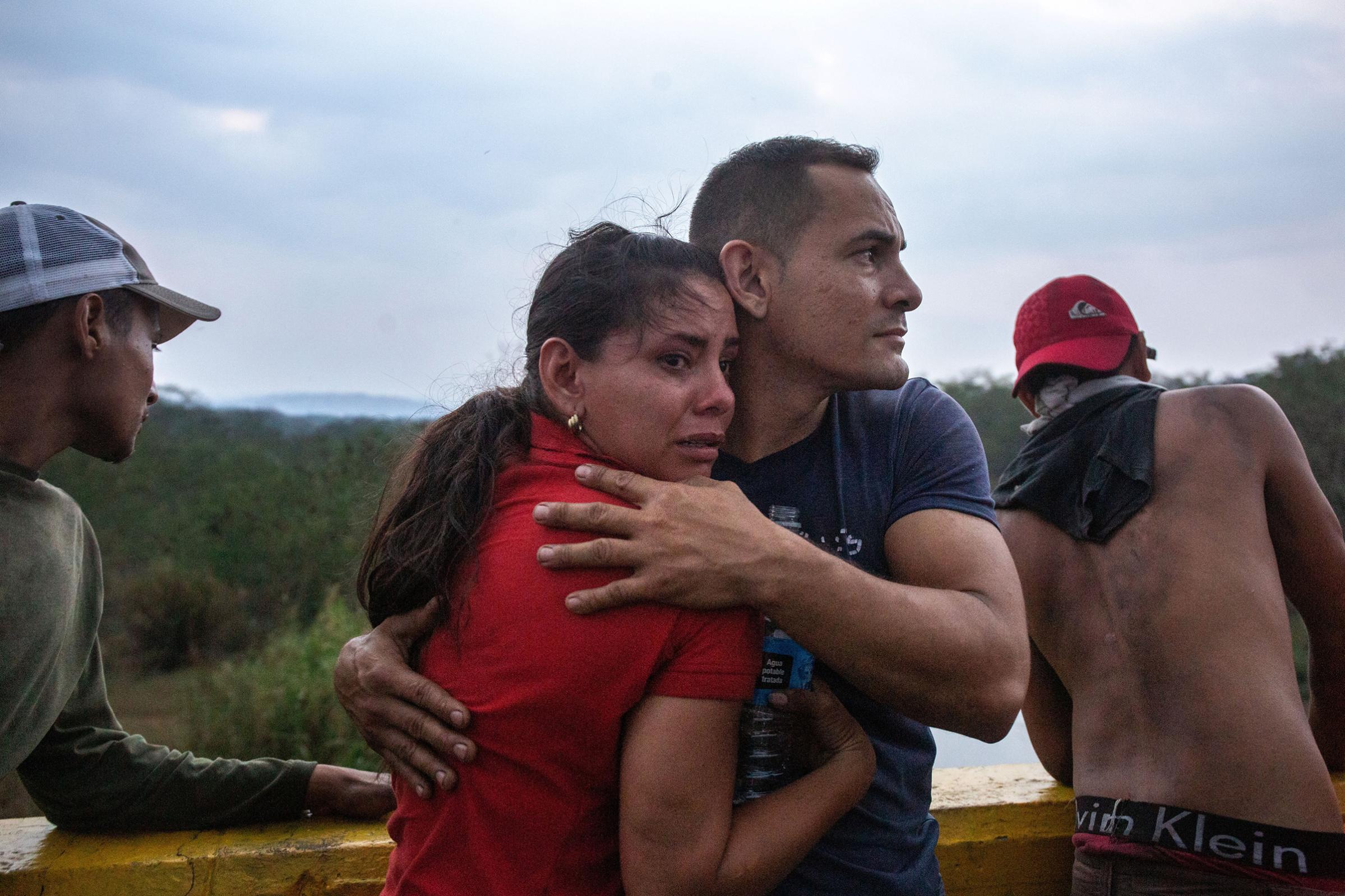
Asense of impending climax followed Juan Guaidó from Venezuela’s capital city to its western border on Feb. 21-22. The young opposition leader is one of two people who claim to be President of the failing petrostate. And at regular intervals on the 500-mile road trip, his caravan pushed through checkpoints manned by the army that answers to the other—Nicolás Maduro, who still clings stubbornly to the presidency after ostensibly winning re-election in a ballot widely seen as stolen.
At each roadblock, the contest for control of Venezuela played out in miniature. Guaidó may be recognized as the legitimate ruler by more than 50 nations, including the U.S. But control of the government depends on those in uniform who hold guns and claim allegiance to Maduro. The challenger’s journey, in defiance of a travel ban imposed by his rival, was a calculated gamble to draw the armed forces into the opposition’s orbit. The plan at the border called for dismantling barricades, then driving waiting truckloads of U.S. food and medical aid into the impoverished land. The idea had an elegant logic. By demonstrating control of both the nation’s armed forces and its borders, Guaidó could effectively exhibit the power he had nominally claimed a month earlier, while also feeding at least a few hungry mouths.
It didn’t happen. The confrontation at the Colombian border on Feb. 23 merely sparked a round of street clashes between security forces and civilians. The aid stayed put, the barricades stayed up, and despite Guaidó’s boast of the “participation” of the armed forces, all but 320 defectors remained loyal to Maduro. If there had been a turning point, it was the grinding sort that becomes apparent only much later.
As the crisis remains stubbornly unresolved, it has grown into a global emergency. The forces aligned against Maduro–including, most prominently, a tough-talking U.S. President Donald Trump–are very nearly as compelling as the country’s extraordinary decline. It has the world’s largest proven oil reserves, yet almost 90% of its people now live below the poverty line. Famed as the birthplace of Latin American liberation, Venezuela in the past three years has lost more than 3 million people, a 10th of its population, to self-exile in nearby countries.
“We’re with you 100%,” U.S. Vice President Mike Pence told Guaidó on Feb. 25, when they met in Colombia with regional leaders.
Despite Trump’s belligerent tone on Venezuela–in striking contrast with his isolationist approach to foreign policy elsewhere–Pence also made clear that no U.S. military action was imminent. Asked whether he had told Guaidó that “all options” remain on the table, “I assured him that they were,” Pence said after the meeting. “But we hope for better. We hope for a peaceful transition.”
Remarkably, Guaidó has emphatically refused to rule out American military intervention. It’s a striking development in a region where Uncle Sam has played the heavy for so long. One historian counted 41 cases of the U.S.’s intervening to change a government in Latin America over the course of about a century–and that’s just the successful ones. The math works out at one every 28 months.

This time, however, Washington is confronting a recalcitrant Latin American government not on its own but with an array of concerned neighbors. The 14 nations that make up the Lima Group, named for the Peruvian capital where they gathered in August 2017 to address the crisis, are committed to restoring democracy in Venezuela, ideally by peaceful means, like enforcing economic sanctions on Maduro cronies and generals to coerce them to abandon his regime.
These countries are strongly opposed to a military solution. Neither Brazil nor Colombia, which border Venezuela, are willing to serve as a base for an assault, which experts and officials warn would carry profound risks. Maduro may be widely unpopular among the starving masses, but he commands the loyalty not just of a corrupt establishment but also of armed groups who are paid by a government not shy about buying support. Geoff Ramsey of the Washington Office on Latin America said an invading force could also expect to face a resistance of 500,000 to 2 million members of an armed militia created by the late President Hugo Chávez in 2008. “Even if 10% head to the hills, you’ve got an insurgency larger than FARC ever were at their peak,” says Ramsey, referring to the insurgent force in Colombia’s 50-year civil war. A U.S.-led invasion, he says, “would be a disaster, a complete logistical nightmare.”
But Latin American leaders are also wary of entering into any “dialogue” with Maduro, who besides presiding over the nation’s collapse also fixed elections, banned political rivals and sidelined parliament. His weakness may be evident in his response to Guaidó’s gambits–when British billionaire Richard Branson staged a concert at Guaidó’s destination on the Colombian border, Maduro mounted one on the Venezuela side–but he still has the support of his allies Russia and China and has offered no hint of a concession.
So the impasse continues. And while the opposition has enjoyed momentum, it’s not clear that time is on its side. The U.S. sanctions on oil production that are meant to isolate Maduro’s supporters may also make life even more desperate for ordinary people when they bite later this year, in a country where lawlessness has been a problem for decades. If ongoing protests in the Venezuelan capital, Caracas, start to resemble the clashes seen on the border, they could be met with a violent crackdown by armed colectivos, Ramsey says. “I am more worried by the government’s lack of control over armed groups than by the potential for protests to turn violent.”
The violence on Feb. 23 offered a preview of what might yet come. In Cúcuta, on the Colombian side, Venezuelan youths hurled rocks toward troops who fired tear gas. But in the streets beyond the troops, men in face masks fired pistols in the air and assaulted dissidents. More than 285 people were reported wounded over the weekend. Four people were killed on the border with Brazil.
The biggest challenge may be for control not of the army but of angry young men. Neyerson Cisneros, a 29-year-old from Caracas, squatted on a pile of aid on one of the flatbeds that had become stranded on the Simón Bolívar International Bridge at Cúcuta. “Military intervention?” he said. “I fully agree. I mean, there’s already intervention from China, Russia and Cuba in Venezuela.” Asked about the chaos that foreign forces might bring, he shrugged. “The thing is, there’s already chaos in Venezuela. So what would it matter?”
— With reporting by Wes Tomaselli/Cúcuta, Colombia
More Must-Reads from TIME
- Donald Trump Is TIME's 2024 Person of the Year
- Why We Chose Trump as Person of the Year
- Is Intermittent Fasting Good or Bad for You?
- The 100 Must-Read Books of 2024
- The 20 Best Christmas TV Episodes
- Column: If Optimism Feels Ridiculous Now, Try Hope
- The Future of Climate Action Is Trade Policy
- Merle Bombardieri Is Helping People Make the Baby Decision
Contact us at letters@time.com